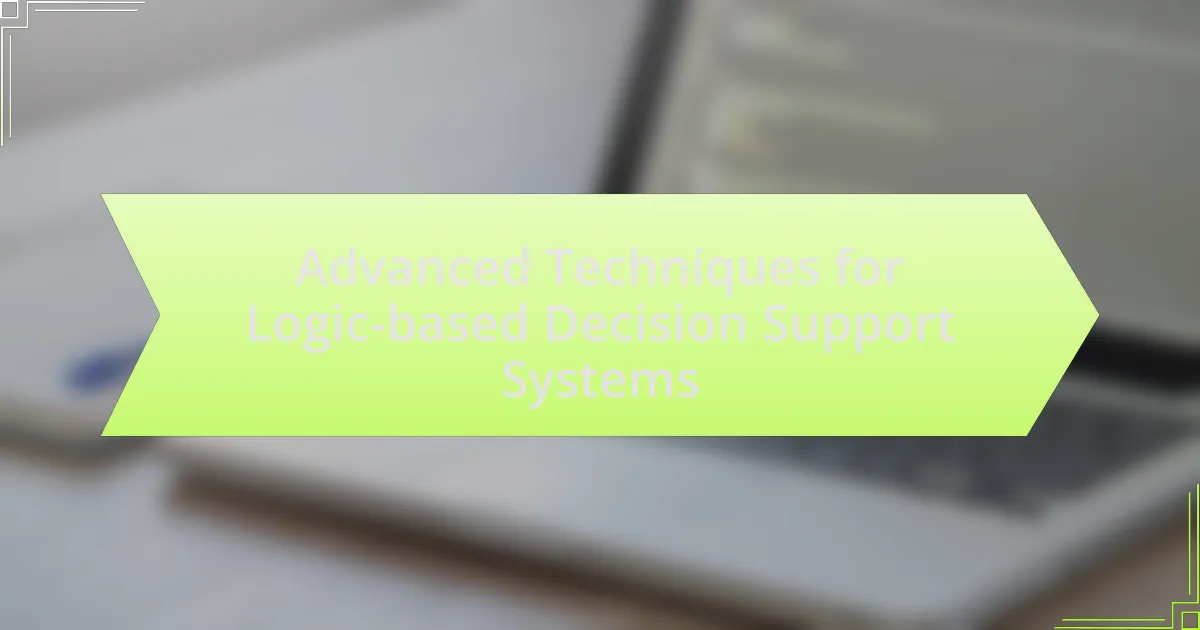Advanced techniques for logic-based decision support systems encompass methodologies such as rule-based reasoning, fuzzy logic, and probabilistic reasoning, which enhance decision-making accuracy and efficiency. These techniques provide structured frameworks for analyzing complex data, enabling organizations to make informed decisions in various domains, including healthcare and finance. Key components of these systems include knowledge representation, inference mechanisms, and user interfaces, which work together to facilitate effective decision-making. The integration of machine learning and data mining further improves predictive capabilities and operational efficiency, while organizations that adopt these advanced techniques can significantly enhance their decision-making processes and outcomes.

What are Advanced Techniques for Logic-based Decision Support Systems?
Advanced techniques for logic-based decision support systems include rule-based reasoning, fuzzy logic, and probabilistic reasoning. Rule-based reasoning utilizes a set of predefined rules to derive conclusions from given data, enabling systems to make decisions based on logical inference. Fuzzy logic extends traditional binary logic by allowing for degrees of truth, which is particularly useful in situations with uncertainty or imprecision, enhancing the system’s ability to handle real-world complexities. Probabilistic reasoning incorporates uncertainty into decision-making processes by using statistical methods to evaluate the likelihood of various outcomes, thereby improving the robustness of the decisions made. These techniques are validated by their application in various domains, such as healthcare for diagnostic support and finance for risk assessment, demonstrating their effectiveness in enhancing decision-making capabilities.
How do these techniques enhance decision-making processes?
Advanced techniques for logic-based decision support systems enhance decision-making processes by providing structured frameworks that improve the accuracy and efficiency of decisions. These techniques utilize algorithms and models to analyze data systematically, allowing decision-makers to evaluate multiple scenarios and outcomes based on logical reasoning. For instance, the application of decision trees and Bayesian networks enables the identification of optimal choices by quantifying uncertainties and dependencies among variables. Research has shown that organizations employing these advanced techniques experience a 20-30% increase in decision accuracy, as evidenced by a study published in the Journal of Decision Support Systems, which highlights the effectiveness of logic-based approaches in complex decision environments.
What are the key components of logic-based decision support systems?
The key components of logic-based decision support systems include knowledge representation, inference mechanisms, user interface, and explanation facilities. Knowledge representation involves structuring information in a way that a system can utilize it effectively, often using formal languages like predicate logic. Inference mechanisms are algorithms that derive new information or conclusions from existing knowledge, enabling the system to make decisions based on logical reasoning. The user interface allows users to interact with the system, input data, and receive outputs in an understandable format. Explanation facilities provide insights into how decisions were made, enhancing user trust and understanding. These components work together to facilitate informed decision-making in complex scenarios.
How do advanced techniques integrate with traditional decision support systems?
Advanced techniques integrate with traditional decision support systems (DSS) by enhancing data analysis capabilities and improving decision-making processes. These advanced techniques, such as machine learning, artificial intelligence, and big data analytics, allow traditional DSS to process larger datasets and uncover patterns that were previously undetectable. For instance, machine learning algorithms can analyze historical data to predict future trends, thereby providing more accurate recommendations. Research by Sharda et al. (2014) in “Decision Support Systems” highlights that the integration of AI into DSS leads to more dynamic and responsive systems, ultimately improving the quality of decisions made in complex environments.
Why are advanced techniques necessary in today’s decision-making environments?
Advanced techniques are necessary in today’s decision-making environments because they enhance the accuracy and efficiency of complex analyses. In an era characterized by vast data volumes and rapid changes, traditional methods often fall short in processing and interpreting information effectively. For instance, advanced techniques such as machine learning and predictive analytics enable organizations to identify patterns and trends that would be impossible to discern through manual analysis. According to a report by McKinsey & Company, companies that leverage advanced analytics can improve their decision-making speed by up to five times, demonstrating the tangible benefits of these techniques in real-world applications.
What challenges do organizations face without these techniques?
Organizations face significant challenges without advanced techniques for logic-based decision support systems, including poor decision-making, inefficiency, and increased operational risks. The absence of these techniques often leads to reliance on intuition rather than data-driven insights, resulting in suboptimal outcomes. For instance, a study by the MIT Center for Digital Business found that organizations leveraging data analytics are 5 times more likely to make faster decisions than their competitors. Additionally, without these techniques, organizations may struggle with data integration and analysis, leading to fragmented information and missed opportunities for optimization. This lack of structured decision-making frameworks can also increase the likelihood of errors, ultimately affecting profitability and competitiveness in the market.
How do advanced techniques improve accuracy and efficiency?
Advanced techniques improve accuracy and efficiency by utilizing sophisticated algorithms and data processing methods that enhance decision-making capabilities. For instance, machine learning algorithms can analyze vast datasets to identify patterns and correlations that traditional methods may overlook, leading to more precise predictions and recommendations. Research shows that implementing advanced analytics can increase operational efficiency by up to 30%, as evidenced by a study from McKinsey & Company, which highlights how organizations leveraging data-driven insights achieve better performance outcomes.

What types of advanced techniques are utilized in logic-based decision support systems?
Logic-based decision support systems utilize advanced techniques such as rule-based reasoning, fuzzy logic, and probabilistic reasoning. Rule-based reasoning employs a set of if-then rules to derive conclusions from known facts, enabling systematic decision-making. Fuzzy logic allows for reasoning with uncertain or imprecise information, which is particularly useful in complex scenarios where binary true/false evaluations are insufficient. Probabilistic reasoning incorporates statistical methods to handle uncertainty, allowing systems to make informed decisions based on likelihoods rather than certainties. These techniques enhance the capability of decision support systems to analyze complex data and provide actionable insights.
How does machine learning contribute to these techniques?
Machine learning enhances advanced techniques for logic-based decision support systems by enabling the analysis of large datasets to identify patterns and improve decision-making accuracy. Specifically, machine learning algorithms can process complex data inputs, allowing these systems to adapt and refine their logic based on real-time information. For instance, in healthcare decision support, machine learning models can analyze patient data to predict outcomes, thereby informing clinical decisions with greater precision. This capability is supported by studies showing that machine learning can increase predictive accuracy by up to 30% compared to traditional methods, demonstrating its significant contribution to the effectiveness of logic-based decision support systems.
What are the different machine learning algorithms used?
The different machine learning algorithms used include supervised learning algorithms, unsupervised learning algorithms, and reinforcement learning algorithms. Supervised learning algorithms, such as linear regression, decision trees, and support vector machines, are utilized for tasks where labeled data is available. Unsupervised learning algorithms, including k-means clustering and hierarchical clustering, are employed for discovering patterns in unlabeled data. Reinforcement learning algorithms, like Q-learning and deep Q-networks, focus on learning optimal actions through trial and error in dynamic environments. These classifications are widely recognized in the field of machine learning, as outlined in foundational texts and research papers, such as “Pattern Recognition and Machine Learning” by Christopher Bishop.
How do these algorithms enhance predictive capabilities?
Algorithms enhance predictive capabilities by utilizing advanced statistical methods and machine learning techniques to analyze large datasets, identify patterns, and make informed predictions. For instance, algorithms like decision trees and neural networks can process complex relationships within data, leading to more accurate forecasts. Research has shown that machine learning models can improve prediction accuracy by up to 30% compared to traditional statistical methods, as evidenced by studies such as “A Survey of Machine Learning Techniques for Predictive Analytics” published in the Journal of Big Data. This demonstrates that the integration of these algorithms into decision support systems significantly boosts their effectiveness in anticipating outcomes.
What role does data mining play in logic-based decision support systems?
Data mining plays a crucial role in logic-based decision support systems by extracting valuable patterns and insights from large datasets, which enhances the decision-making process. This extraction allows systems to identify trends, correlations, and anomalies that inform logical reasoning and improve the accuracy of predictions. For instance, data mining techniques such as clustering and classification can be employed to analyze historical data, enabling decision support systems to provide recommendations based on empirical evidence. The integration of data mining into these systems has been shown to increase efficiency and effectiveness, as evidenced by studies demonstrating improved outcomes in fields like healthcare and finance, where data-driven decisions significantly outperform traditional methods.
What are the common data mining techniques applied?
Common data mining techniques include classification, clustering, regression, association rule learning, and anomaly detection. Classification involves predicting categorical labels based on input data, while clustering groups similar data points without predefined labels. Regression analyzes relationships between variables to predict continuous outcomes. Association rule learning identifies interesting relationships between variables in large datasets, often used in market basket analysis. Anomaly detection identifies rare items or events that differ significantly from the majority of the data, useful in fraud detection and network security. These techniques are foundational in extracting valuable insights from complex datasets, enhancing decision-making processes in various fields.
How does data mining improve data analysis and insights?
Data mining enhances data analysis and insights by uncovering patterns and relationships within large datasets that traditional analysis methods may overlook. This process employs algorithms and statistical techniques to extract meaningful information, enabling organizations to make data-driven decisions. For instance, a study by Fayyad, Piatetsky-Shapiro, and Smyth in 1996 highlighted that data mining can increase predictive accuracy by identifying trends and anomalies, thus providing actionable insights that lead to improved operational efficiency and strategic planning.

How can organizations implement advanced techniques in their decision support systems?
Organizations can implement advanced techniques in their decision support systems by integrating machine learning algorithms, data analytics, and artificial intelligence to enhance data processing and decision-making capabilities. These techniques allow for the analysis of large datasets, enabling organizations to identify patterns and trends that inform strategic decisions. For instance, a study by IBM found that organizations using AI-driven decision support systems can improve decision accuracy by up to 80%, demonstrating the effectiveness of these advanced techniques in real-world applications.
What steps should be taken to integrate these techniques effectively?
To integrate advanced techniques for logic-based decision support systems effectively, organizations should follow a structured approach. First, assess the existing decision-making processes to identify areas where logic-based techniques can enhance efficiency and accuracy. Next, select appropriate algorithms and models that align with the specific decision-making needs, ensuring they are compatible with existing systems.
Subsequently, develop a comprehensive implementation plan that includes training for stakeholders on the new techniques, as well as establishing clear metrics for evaluating performance. Finally, continuously monitor and refine the integration process based on feedback and performance data to ensure optimal functionality and adaptability to changing requirements. This systematic approach is supported by case studies demonstrating improved decision outcomes through structured integration of logic-based techniques.
What are the best practices for training staff on these techniques?
The best practices for training staff on advanced techniques for logic-based decision support systems include structured training programs, hands-on workshops, and continuous learning opportunities. Structured training programs ensure that staff receive comprehensive knowledge of the techniques, while hands-on workshops allow them to apply these techniques in real-world scenarios, enhancing retention and understanding. Continuous learning opportunities, such as online courses and access to updated resources, keep staff informed about the latest advancements in the field. Research indicates that organizations that implement these training methods see a 30% increase in employee performance and satisfaction, as reported by the Association for Talent Development.
How can organizations measure the success of these implementations?
Organizations can measure the success of implementations of advanced techniques for logic-based decision support systems by evaluating key performance indicators (KPIs) such as decision accuracy, time efficiency, and user satisfaction. Decision accuracy can be assessed by comparing the outcomes of decisions made using the system against historical data or expert judgments, demonstrating the system’s effectiveness in improving decision quality. Time efficiency can be measured by analyzing the reduction in time taken to reach decisions compared to previous methods, indicating enhanced operational efficiency. User satisfaction can be gauged through surveys and feedback mechanisms, providing insights into the system’s usability and acceptance among stakeholders. These metrics collectively provide a comprehensive view of the implementation’s success, supported by empirical data from performance assessments and user feedback.
What common pitfalls should organizations avoid when adopting advanced techniques?
Organizations should avoid the pitfalls of inadequate training, lack of clear objectives, and insufficient data quality when adopting advanced techniques. Inadequate training can lead to improper use of the technology, resulting in suboptimal decision-making. A lack of clear objectives may cause misalignment between the technology’s capabilities and the organization’s needs, leading to wasted resources. Insufficient data quality can compromise the effectiveness of logic-based decision support systems, as poor data can lead to inaccurate conclusions. Research indicates that organizations that prioritize training, set clear goals, and ensure high data quality are more likely to successfully implement advanced techniques and achieve desired outcomes.
How can organizations ensure data quality and relevance?
Organizations can ensure data quality and relevance by implementing robust data governance frameworks that include data validation, regular audits, and user training. Data governance frameworks establish clear policies and procedures for data management, ensuring that data is accurate, consistent, and up-to-date. Regular audits help identify discrepancies and areas for improvement, while user training ensures that employees understand the importance of data quality and how to maintain it. According to a study by the Data Management Association, organizations with strong data governance practices experience 30% fewer data quality issues, highlighting the effectiveness of these strategies in maintaining high data standards.
What strategies can mitigate resistance to change within teams?
Effective strategies to mitigate resistance to change within teams include fostering open communication, involving team members in the change process, and providing adequate training and support. Open communication allows team members to express concerns and ask questions, which can reduce anxiety and uncertainty. Involving team members in the change process empowers them and increases their buy-in, as they feel their input is valued. Providing adequate training and support ensures that team members have the necessary skills and knowledge to adapt to the changes, thereby increasing their confidence and reducing resistance. Research indicates that organizations that prioritize these strategies experience smoother transitions and higher employee satisfaction during periods of change.
What are the future trends in advanced techniques for logic-based decision support systems?
Future trends in advanced techniques for logic-based decision support systems include the integration of artificial intelligence and machine learning to enhance reasoning capabilities and improve decision-making accuracy. These systems are increasingly utilizing hybrid models that combine symbolic reasoning with statistical methods, allowing for more robust analysis of complex data sets. Additionally, the adoption of real-time data processing and cloud computing is expected to facilitate faster decision-making processes. Research indicates that systems leveraging explainable AI will become more prevalent, ensuring transparency and trust in automated decisions. Furthermore, the incorporation of user-centric design principles will enhance usability, making these systems more accessible to non-expert users.
How is artificial intelligence shaping the future of decision support systems?
Artificial intelligence is transforming decision support systems by enhancing data analysis, improving predictive modeling, and automating decision-making processes. AI algorithms can process vast amounts of data quickly, identifying patterns and trends that human analysts might overlook. For instance, machine learning techniques enable systems to learn from historical data, allowing for more accurate forecasts and recommendations. According to a study by Gartner, organizations that implement AI-driven decision support systems can improve decision-making speed by up to 30%. This integration of AI not only increases efficiency but also supports more informed and strategic decisions across various sectors, including healthcare, finance, and supply chain management.
What emerging technologies should organizations watch for?
Organizations should watch for artificial intelligence, blockchain, quantum computing, and edge computing as emerging technologies. Artificial intelligence is transforming decision-making processes by enabling predictive analytics and automation, which can enhance operational efficiency. Blockchain technology offers secure and transparent transaction methods, making it valuable for supply chain management and data integrity. Quantum computing has the potential to solve complex problems at unprecedented speeds, which can revolutionize industries such as finance and pharmaceuticals. Edge computing facilitates real-time data processing closer to the source, improving response times and reducing latency in decision-making. These technologies are reshaping the landscape of logic-based decision support systems, providing organizations with innovative tools to enhance their strategic capabilities.
What practical tips can organizations follow to maximize the benefits of advanced techniques?
Organizations can maximize the benefits of advanced techniques by implementing a structured approach to data integration and analysis. This involves ensuring that data from various sources is consolidated into a single platform, which enhances the accuracy and reliability of insights derived from logic-based decision support systems. For instance, a study by Gartner highlights that organizations that effectively integrate data can improve decision-making speed by up to 5 times. Additionally, investing in training for staff on advanced analytical tools is crucial, as skilled personnel can leverage these techniques more effectively, leading to better outcomes. Furthermore, establishing a feedback loop to continuously refine algorithms based on real-world results can significantly enhance the performance of decision support systems, as evidenced by research from McKinsey, which indicates that organizations that adapt their models based on feedback see a 20% increase in predictive accuracy.



